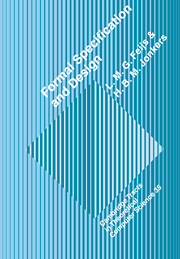11 - Towards large systems
Published online by Cambridge University Press: 02 November 2009
Summary
Introduction
All the previous chapters are about techniques for unambiguously specifying hardware/software systems and transforming abstract specifications into efficient programs. One important motivation for presenting these techniques is the fact that it is often useful to have a distinction between the external view and the internal view of a system. The external view can take the form of a formal specification and it can be optimised with respect to abstractness, compactness and clarity. The internal view is a program which is devised with efficiency in mind. To have two descriptions corresponding to these two views can be considered as a separation of concerns: it helps to manage the complexity of large systems.
This approach introduces additional formal texts when compared with the older approaches dealing mostly with programs. As a consequence, care is needed to maintain the overview of all formal texts that arise when designing large systems.
This chapter presents two techniques developed in the context of COLD-K which serve for keeping this overview. These are certainly not the only useful techniques; they should be complemented with additional graphical techniques and classical software engineering techniques for configuration management, project management, etc. The first technique is to use simple pictures showing the modular structure of a formal specification. This is the topic of Section 11.2. The second technique is to add structure, putting specifications and implementations together in simple language constructs called components and designs. This is the topic of Section 11.3. Finally, Sections 11.4 and 11.5 present a number of applications as well as some concluding remarks.
- Type
- Chapter
- Information
- Formal Specification and Design , pp. 287 - 302Publisher: Cambridge University PressPrint publication year: 1992



